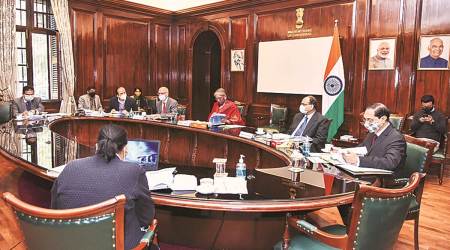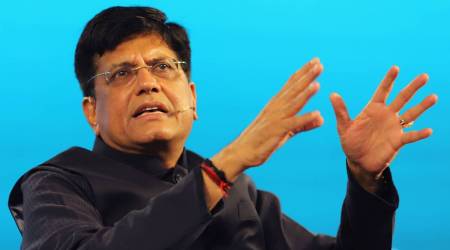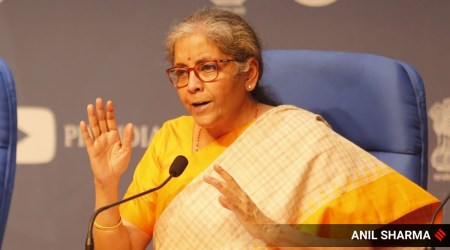ECONOMY NEWS - Page 110
RBI Governor Shaktikanta Das: Recovery not steady and continuous yet
Members of the RBI’s Monetary Policy Committee raised concerns on the status of some of the sub-sectors and aspects of the economy while stating that it might take at least a year to reach the earlier peak GDP level and more to recover lost growth.
FM Sitharaman lists out healthcare, infra, livelihood as key focus areas
The Finance Minister said investment in health and infrastructure is going to be absolutely critical, while livelihood challenges would have to be seen in a newer canvas.
From telecom spectrum auction to sugar export subsidy: Here are key Cabinet announcements
Telecom Spectrum Auction: Spectrum in 700 MHz, 800 MHz, 900 MHz, 1800 MHz, 2100 MHz, 2300 MHz and 2500 MHz frequency bands would be auctioned for a validity period of 20 years.
S&P raises FY21 growth forecast to 7.7% contraction
For FY22, S&P projected growth to rebound to 10 per cent. Its revision in growth forecast for the current fiscal reflects a faster-than-expected recovery in the September quarter.
FSDC Meeting: Recovery to be faster than predicted; focus on support for financial sector
Budget proposals submitted by the Reserve Bank of India and other regulators were discussed at the meeting.
FDI into India continuously growing: Commerce Minister Goyal
The minister said that 100 per cent FDI is allowed through automatic route in almost all sectors.
Facebook’s Mark Zuckerberg and RIL’s Mukesh Ambani talk WhatsApp, JioMartSubscriber Only
Facebook-Reliance Jio partnership: Ambani also talked about the Jio-Facebook partnership stressing on WhatsApp in particular and the role it would play with the company’s ‘Jio Mart’ service. Both Jio and WhatsApp have a base of over 400 million customers in India.
India’s retail inflation dips to 6.93% in November
India CPI Inflation Rate November 2020: The retail inflation which is measured by the Consumer Price Index (CPI) was 6.93 per cent in November, government data revealed.
November: Wholesale, retail inflation diverge again
Retail inflation based on the Consumer Price Index (CPI) had stood at 7.61 per cent in October, while WPI inflation was 1.48 per cent in October.
Gadkari calls on India Inc to find Swadeshi alternatives to imports
The minister urged the industry to look into products, like magnets and lithium ion batteries, that are being imported and what is being produced domestically.
Amitabh Kant: Need to focus on sunrise sectors
NITI Aayog CEO Amitabh Kant said it has taken a series of measures to make India highly competitive in the global economy.
Forex reserves surge to record $579.3 bn
In the previous week ended November 27, the reserves had declined by $469 million to $574.821 billion.
FinMin okays Rs 9,879 crore capex proposal of 27 states
The capital expenditure projects have been approved in diverse sectors like, health, rural development, water supply, irrigation, power, transport, education, urban development.
India’s economic recovery faster than expected, says PM Modi
Modi emphasised on the priority given to “saving lives” during the pandemic and said that the “the government's policies and actions were oriented towards that.”
Govt cancels 1.63 lakh GST registrations
Sources said GST entities that had not filed their GSTR-3B returns for over six months were first issued the cancellation notices and, then, their registrations were cancelled in accordance with the standard operating procedure.
Festive demand drives auto sales: PVs up 4.65%, two-wheelers 13.4%
Even as November turned out to be a good month, industry insiders feel that sales growth going forward would depend more on the overall economic scenario.
Factory output rises to eight-month high on manufacturing, electricity boost
Factory output had contracted by 6.6 per cent in October 2019. Cumulatively, factory output for April-October has shrunk by 17.5 per cent as against 0.1 per cent growth in the year-ago period.
Divestment policy to be far more ambitious: DEA Secy
“We are positive. We are cautiously optimistic on the economic front. We are hoping that the third and the fourth quarter will be better than the first and second,” Department of Economic Affairs Secretary Tarun Bajaj said.
NK Singh: Central schemes need more rationalisation
Require panel to review allocation of legislative powers between Centre & states in Schedule VII of Constitution, said 15th Finance Commission Chairman NK Singh.
IIP Data October 2020: India’s industrial output climbs 3.6% in October, says Govt data
IIP India Growth Rate Data October 2020: The industrial growth so far in the fiscal year 2020-21 (April-October) has contracted 17.5 per cent, compared to a 0.1 per cent rise in the corresponding period year ago, the data from Ministry of Statistics & Programme Implementation (MoSPI) showed.
Fitch revises India GDP forecast, sees contraction at 9.4%
In its Global Economic Outlook, Fitch said the coronavirus recession has inflicted severe economic scarring and the country needs to repair balance sheets and increase caution about long-term planning.
Forex reserves slip off record high, at $574.8 bn for week ended November 27
Weekly data released by the Reserve Bank of India (RBI) showed that FCA rose by $352 million to $533.455 billion.
GST shortfall: Jharkhand opts in, all states now onboard Centre’s borrowing plan
Jharkhand will get Rs 1,689 crore through the special borrowing window to meet the GST implementation shortfall, while it has been permitted to raise an additional Rs 1,765 crore.
Citing inflation concern, RBI holds key rate; says recovery needs supportSubscriber Only
In its bi-monthly monetary policy, the central bank also offered more funds to 26 stressed sectors in the Covid-hit economy to maintain the tempo of the recovery.
Yet to take decision on industrial houses in banking, says Shaktikanta DasSubscriber Only
The decision to allow industrial houses to control banks has evoked much debate and controversy at a time when there have been multiple bank failures leading to bailouts.
Best of Express























































